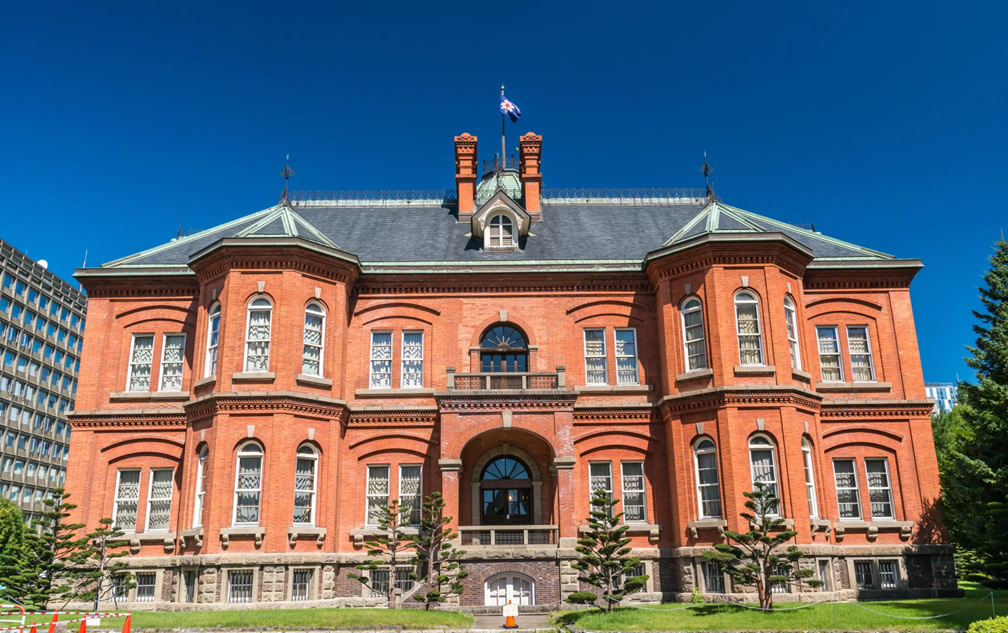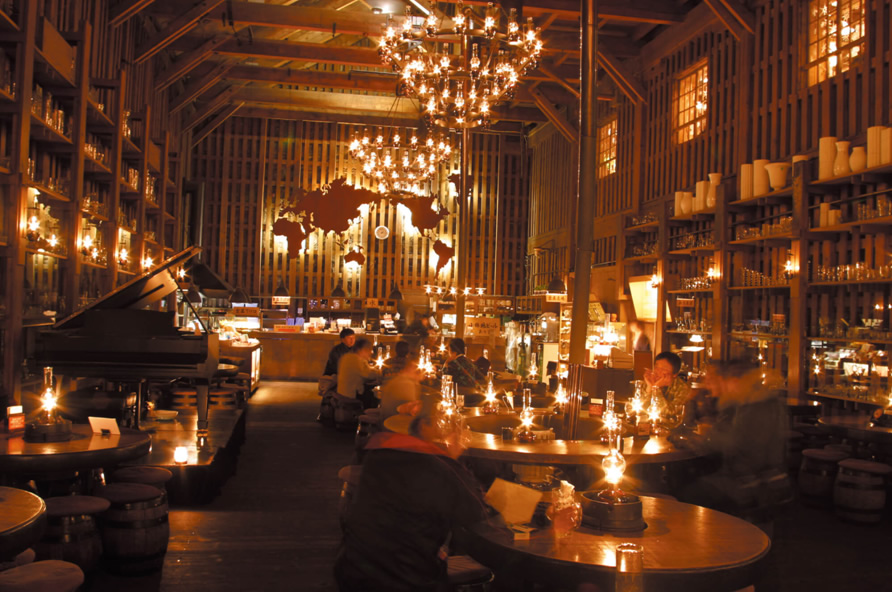Former Hokkaidō Government Office

A historic landmark that seamlessly blends rich history with stunning architectural beauty. Often referred to as the "Red Brick Office," this iconic building stands as a testament to Hokkaidō's vibrant past and cultural heritage.
Constructed in 1888, the Former Hokkaidō Government Office is an exquisite example of Neo-Baroque architecture, characterized by its distinctive red bricks and elegant design. Drawing inspiration from the esteemed Massachusetts State House in the United States, this building infuses a touch of American influence into its design. Approximately 2.5 million red bricks were meticulously placed during construction, contributing to the building's distinctive appearance and earning it the affectionate moniker, "Red Brick Office."
As you step inside, you'll be transported back in time, with each room telling a unique story of Hokkaidō's development and its pivotal role in Japan's modernization.
Visitors can explore a variety of exhibits that showcase Hokkaidō's history, from its indigenous Ainu culture to its agricultural and industrial advancements. The building also houses an extensive library and archives, providing a treasure trove of information for history enthusiasts.
Surrounded by beautifully landscaped gardens, the Former Hokkaidō Government Office offers a serene escape from the hustle and bustle of city life. The gardens are particularly enchanting during the cherry blossom season and in autumn when the leaves transform into a vibrant tapestry of colors.
Sapporo Beer Museum
In 1869 (Meiji 2), the Meiji government established the Colonization Commission to promote agriculture, industry, and commerce. At that time, the government invited officials from the Colonization Commission, Kubota Kyusei, and Nakagawa Seibei, who had studied beer brewing technology in Germany,establish the
government-operated model brewery "Colonization Commission Beer Brewing Facility" in 1876 (Meiji 9). They constructed the factory at the site of the current Sapporo Brewery.
The brick building that houses the Sapporo Beer Museum was originally erected in 1888 (Meiji 21) as a sugar factory by the "Sapporo Sugar" company and completed in 1890 (Meiji 23). However, due to challenges in securing raw materials such as sugar beets and encountering frequent setbacks, the sugar company faced a period of decline, ultimately leading to its dissolution.
Meanwhile, the burgeoning demand for beer production necessitated the expansion of manufacturing facilities. In 1903 (Meiji 36), the brewery acquired the aforementionedbrick sugar factory, repurposing it as a malt factory. Despite undergoing several rounds of renovation and reinforcement, the building ceased operations in 1965 (Showa 40).
In 1966 (Showa 41), commemorating the 90th anniversary of Sapporo Beer's establishment, the structure was repurposed as the "Colonization Commission Beer Memorial Hall," alongside the inauguration of the "Sapporo Beer Garden" beer hall. Although there were initial discussions regarding the demolition of the building, mounting calls for the preservation of historical architecture prompted its reopening in 1987 (Showa 62) as the "Sapporo Beer Museum."
The Ministry of Culture proposed designating the museum as a National Important Cultural Property. However, considering the logistical challenges associated with refurbishing the building and interior facilities post-designation, coupled with Sapporo Beer Company's steadfast commitment to preservation, the proposal was graciously declined.
The museum underwent extensive renovations in 2004 (Heisei 16) and 2016 (Heisei 28), ensuring its continued relevance as a cherished repository of Japan's brewing heritage.
Kitaichi Glass Otaru

Asahara Glass, the predecessor of Kitaichi Glass, was founded in 1903, the year before construction of the Otaru-Hakodate railway began. The first president, HisakichiAsahara, moved from Kyushu, the birthplace of Satsuma Kiriko, to Hokkaido and began manufacturing oil lamps in Otaru. At a time when electricity was not widespread, oil lamps manufactured by Asahara Glass were a necessity for people's daily lives. Furthermore, in 1901, the company began manufacturing floating balls for fishing, and expanded manufacturing factories in Otaru, Muroran, Asahikawa, Kushiro, and Sakhalin, and the number of employees increased to about 400, making it one of the largest companies in Hokkaido at the time.
Otaru is a region that developed rapidly in Japan after the Meiji era. It also achieved rapid development as a gateway port for the development of the entire area of Hokkaido, as a shipping port for exporting Hokkaido products, and as a relay port to Sakhalin. This was also a time when various foreign cultures and civilizations flooded into Japan as part of the Meiji government's national policy of lifting national isolation. New railways, mansions, temples and shrines, inns, restaurants, and more were being built.
However, with the end of the war in 1945, major development came to a complete halt. Due to subsequent legal revisions and changes in social conditions, the core of Hokkaido's economy was completely shifted to Sapporo in the 1960s, and Otaru remained for some time with the adjective ``swanning''.However, not all of the great cultural heritage was lost. The buildings and townscapes of the Meiji and Taisho periods remain in their original form as valuable cultural heritage. Having correctly recognized the value of this precious historical and cultural heritage, our major theme at Kitaichi Glass is how to achieve harmony with glass.
Otaru Canal
The Otaru Canal was constructed to handle the increasing volume of cargo at Otaru Port, allowing barges to unload goods directly near the warehouses. After the war, with the improvement of port facilities, the canal had fulfilled its purpose, leaving behind many historic wooden and stone warehouses. In 1966, to alleviate the
worsening traffic congestion in Otaru City due to motorization, the government planned to expand the coastal road (now part of Hokkaido Route 17 Otaru Port Line and Hokkaido Route 454 Otaru Coastal Park Line) into a six-lane highway, which involved filling in the canal and demolishing the warehouse group. This sparked a movement among citizens to preserve the surrounding historic buildings, leading to the establishment of the "Otaru Canal Protection Association" in 1973. After more than a decade of discussions, a portion of the canal was ultimately preserved.
The revitalized Otaru Canal has now become a symbolic tourist destination in Otaru, with increased private investment in the area. The surroundings of the Otaru Canal have been designated as the "Otaru Historic Landscape Area," where wooden and stone warehouses have been repurposed, and new buildings designed to harmonize with the
historical architecture have been constructed. This has attracted businesses such as glass workshops, music box workshops, restaurants, seafood shops, confectionery shops, and souvenir shops. Visitors can tour the canal area by rickshaw, and since 2012, sightseeing boats have also been operating, offering tours around the canal.
Agenda & Notice
Agenda
| 9:00 | Conference Venue |
| 9:15 | Former Hokkaidō Government Office |
| 10:00 | Sapporo Beer Museum |
| 12:30 | Lunch |
| 14:00 | Kitaichi Glass Otaru |
| 15:30 | Otaru Canal |
| 18:00 | Conference Venue |
Rates
| 1. | Conference delegate: $ 120 USD per person |
| 2. | Accompanying person: $ 130 USD per person |
Reservation and Payment Deadline / July 1st, 2024
Attention
| 1. | The schedule and itinerary may be changed due to unpredictable factors such as traffic and weather. |
| 2. | The reservation will be automatically cancelled if no payment is received by July 1st, 2024. |
| 3. | A minimum of 10 people is required to operate a tour. If the minimum is not reached, the tour will be cancelled and a noticed with method of refund will be sent to the registrants from July 5, 2024. |
| 4. | If participants cancel the reservation for personal reasons, the cancelation charge will be applied as below: From July 5, 2024: Nonrefundable |
Important Information
| 1. | We recommend you to wear the casual clothes and comfortable shoes. |
| 2. | If the attraction is invisible due to weather conditions, the tour will not be canceled and fees will not be refunded. |
| 3. | Participants should follow the tour guide’s instructions; HEF and the tour guide are not responsible for participants’ leave without notice and personal activities. |
| 4. | The tour bus will not wait for any personal excuse. |


